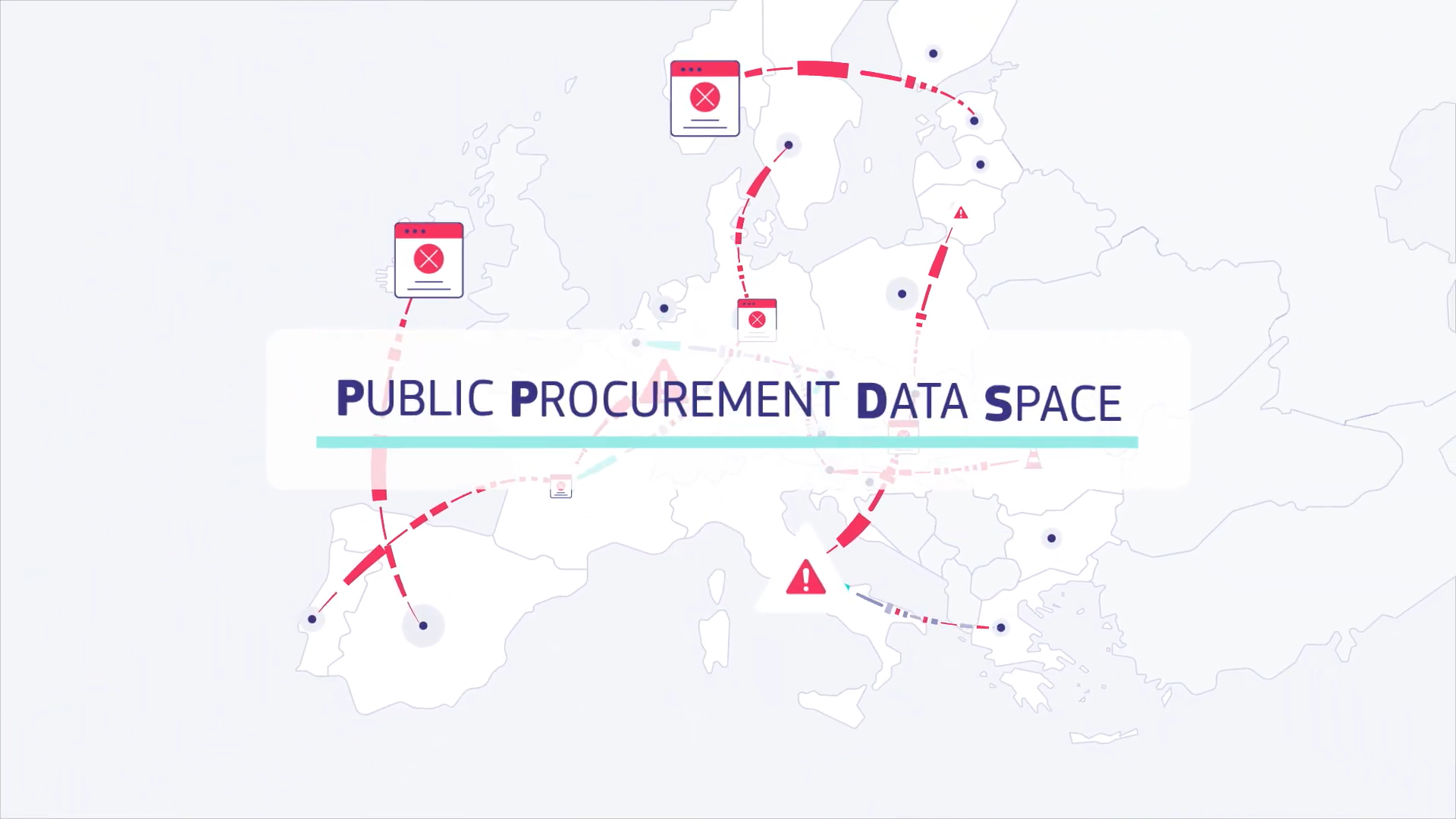The PPDS thus intends to develop a ‘technical fix’ to gain a view on the below-threshold reality of procurement across the EU, by ‘pulling and pooling’ data from existing (and to be developed) domestic public contract registers and transparency portals. The PPDS is thus a mechanism for the aggregation of procurement data currently not available in (harmonised) machine-readable and structured formats (or at all).
As the PPDS Communication makes clear, it consists of four layers:
(1) A user interface layer (ie a website and/or app) underpinned by
(2) an analytics layer, which in turn is underpinned by (3) an integration layer that brings together and minimally quality-assures the (4) data layer sourced from TED, Member State public contract registers (including those at sub-national level), and data from other sources (eg data on beneficial ownership).
The two top layers condense all potential advantages of the PPDS, with the analytics layer seeking to develop a ‘toolset including emerging technologies (AI, ML and NLP)‘ to extract data insights for a multiplicity of purposes (see below 3), and the top user interface seeking to facilitate differential data access for different types of users and stakeholders (see below 4). The two bottom layers, and in particular the data layer, are the ones doing all the heavy lifting. Unavoidably, without data, the PPDS risks being little more than an empty shell. As always, ‘no data, no fun’ (see below 5).
Importantly, the top three layers are centralised and the European Commission has responsibility (and funding) for developing them, while the bottom data layer is decentralised, with each Member State retaining responsibility for digitalising its public procurement systems and connecting its data sources to the PPDS. Member States are also expected to bear their own costs, although there is EU funding available through different mechanisms. This allocation of responsibilities follows the limited competence of the EU in this area of inter-administrative cooperation, which unfortunately heightens the risks of the PPDS becoming little more than an empty shell, unless Member States really take the implementation of eForms and the collaborative approach to the construction of the PPDS seriously (see below 6).
The PPDS Communication foresees a progressive implementation of the PPDS, with the goal of having ‘the basic architecture and analytics toolkit in place and procurement data published at EU level available in the system by mid-2023. By the end of 2024, all participating national publication portals would be connected, historic data published at EU level integrated and the analytics toolkit expanded. As of 2025, the system could establish links with additional external data sources’ (at 2). It will most likely be delayed, but that is not very important in the long run—especially as the already accrued delays are the ones that pose a significant limitation on the adequate rollout of the PPDS (see below 6).
3. PPDS’ expected functionality
The PPDS Communication sets expectations around the functionality that could be extracted from the PPDS by different agents and stakeholders.
For public buyers, in addition to reducing the burden of complying with different types of (EU-mandated) reporting, the PPDS Communication expects that ‘insights gained from the PPDS will make it much easier for public buyers to
team up and buy in bulk to obtain better prices and higher quality;
generate more bids per call for tenders by making calls more attractive for bidders, especially for SMEs and start-ups;
fight collusion and corruption, as well as other criminal acts, by detecting suspicious patterns;
benchmark themselves more accurately against their peers and exchange knowledge, for instance with the aim of procuring more green, social and innovative products and services;
through the further digitalisation and emerging technologies that it brings about, automate tasks, bringing about considerable operational savings’ (at 2).
This largely maps onto my analysis of likely applications of digital technologies for procurement management, assuming the data is there (see here).
The PPDS Communication also expects that policy-makers will ‘gain a wealth of insights that will enable them to predict future trends‘; that economic operators, and SMEs in particular, ‘will have an easy-to-use portal that gives them access to a much greater number of open call for tenders with better data quality‘, and that ‘Citizens, civil society, taxpayers and other interested stakeholders will have access to much more public procurement data than before, thereby improving transparency and accountability of public spending‘ (at 2).
Of all the expected benefits or functionalities, the most important ones are those attributed to public buyers and, in particular, the possibility of developing ‘category management’ insights (eg potential savings or benchmarking), systems of red flags in relation to corruption and collusion risks, and the automation of some tasks. However, unlocking most of these functionalities is not dependent on the PPDS, but rather on the existence of procurement data at the ‘right’ level.
For example, category management or benchmarking may be more relevant or adequate (as well as more feasible) at national than at supra-national level, and the development of systems of red flags can also take place at below-EU level, as can automation. Importantly, the development of such functionalities using pan-EU data, or data concerning more than one Member State, could bias the tools in a way that makes them less suited, or unsuitable, for deployment at national level (eg if the AI is trained on data concerning solely jurisdictions other than the one where it would be deployed).
In that regard, the expected functionalities arising from PPDS require some further thought and it can well be that, depending on implementation (in particular in relation to multi-speed datafication, as below 5), Member States are better off solely using domestic data than that coming from the PPDS. This is to say that PPDS is not a solid reality and that its enabling character will fluctuate with its implementation.
4. Differential procurement data access through PPDS
As mentioned above, the PPDS Communication stresses that ‘Citizens, civil society, taxpayers and other interested stakeholders will have access to much more public procurement data than before, thereby improving transparency and accountability of public spending’ (at 2). However, this does not mean that the PPDS will be (entirely) open data.
The Communication itself makes clear that ‘Different user categories (e.g. Member States, public buyers, businesses, citizens, NGOs, journalists and researchers) will have different access rights, distinguishing between public and non-public data and between participating Member States that share their data with the PPDS (PPDS members, …) and those that need more time to prepare’ (at 8). Relatedly, ‘PPDS members will have access to data which is available within the PPDS. However, even those Member States that are not yet ready to participate in the PPDS stand to benefit from implementing the principles below, due to their value for operational efficiency and preparing for a more evidence-based policy’ (at 9). This raises two issues.
First, and rightly, the Communication makes clear that the PPDS moves away from a model of ‘fully open’ or ‘open by default’ procurement data, and that access to the PPDS will require differential permissioning. This is the correct approach. Regardless of the future procurement data governance framework, it is clear that the emerging thicket of EU data governance rules ‘requires the careful management of a system of multi-tiered access to different types of information at different times, by different stakeholders and under different conditions’ (see here). This will however raise significant issues for the implementation of the PPDS, as it will generate some constraints or disincentives for an ambitions implementation of eForms at national level (see below 6).
Second, and less clearly, the PPDS Communication evidences that not all Member States will automatically have equal access to PPDS data. The design seems to be such that Member States that do not feed data into PPDS will not have access to it. While this could be conceived as an incentive for all Member States to join PPDS, this outcome is by no means guaranteed. As above (3), it is not clear that Member States will be better off—in terms of their ability to extract data insights or to deploy digital technologies—by having access to pan-EU data. The main benefit resulting from pan-EU data only accrues collectively and, primarily, by means of facilitating oversight and enforcement by the European Commission. From that perspective, the incentives for PPDS participation for any given Member State may be quite warped or internally contradictory.
Moreover, given that plugging into PPDS is not cost-free, a Member State that developed a data architecture not immediately compatible with PPDS may well wonder whether it made sense to shoulder the additional costs and risks. From that perspective, it can only be hoped that the existence of EU funding and technical support will be maximised by the European Commission to offload that burden from the (reluctant) Member States. However, even then, full PPDS participation by all Member States will still not dispel the risk of multi-speed datafication.
5. No data, no fun — and multi-speed datafication
Related to the risk that some EU Member States will become PPDS members and others not, there is a risk (or rather, a reality) that not all PPDS members will equally contribute data—thus creating multi-speed datafication, even within the Member States that opt in to the PPDS.
First, the PPDS Communication makes it clear that ‘Member States will remain in control over which data they wish to share with the PPDS (beyond the data that must be published on TED under the Public Procurement Directives)‘ (at 7), It further specifies that ‘With the eForms, it will be possible for the first time to provide data in notices that should not be published, or not immediately. This is important to give assurance to public buyers that certain data is not made publicly available or not before a certain point in time (e.g. prices)’ (at 7, fn 17).
This means that each Member State will only have to plug whichever data it captures and decides to share into PPDS. It seems plain to see that this will result in different approaches to data capture, multiple levels of granularity, and varying approaches to restricting access to the date in the different Member States, especially bearing in mind that ‘eForms are not an “off the shelf” product that can be implemented only by IT developers. Instead, before developers start working, procurement policy decision-makers have to make a wide range of policy decisions on how eForms should be implemented’ in the different Member States (see eForms Implementation Handbook, at 9).
Second, the PPDS Communication is clear (in a footnote) that ‘One of the conditions for a successful establishment of the PPDS is that Member States put in place automatic data capture mechanisms, in a first step transmitting data from their national portals and contract registers’ (at 4, fn 10). This implies that Member States may need to move away from manually inputted information and that those seeking to create new mechanisms for automatic procurement data capture can take an incremental approach, which is very much baked into the PPDS design. This relates, for example, to the distinction between pre- and post-award procurement data, with pre-award data subjected to higher demands under EU law. It also relates to above and below threshold data, as only above threshold data is subjected to mandatory eForms compliance.
In the end, the extent to which a (willing) Member State will contribute data to the PPDS depends on its decisions on eForms implementation, which should be well underway given the October 2023 deadline for mandatory use (for above threshold contracts). Crucially, Member States contributing more data may feel let down when no comparable data is contributed to PPDS by other Member States, which can well operate as a disincentive to contribute any further data, rather than as an incentive for the others to match up that data.
6. Ambitious eForms implementation as the PPDS’ Achilles heel
As the analysis above has shown, the viability of the PPDS and its fitness for purpose (especially for EU-level oversight and enforcement purposes) crucially depends on the Member States deciding to take an ambitious approach to the implementation of eForms, not solely by maximising their flexibility for voluntary uses (as discussed here) but, crucially, by extending their mandatory use (under national law) to all below threshold procurement. It is now also clear that there is a need for as much homogeneity as possible in the implementation of eForms in order to guarantee that the information plugged into PPDS is comparable—which is an aspect of data quality that the PPDS Communication does not seem to have at all considered).
It seems that, due to competing timings, this poses a bit of a problem for the rollout of the PPDS. While eForms need to be fully implemented domestically by October 2023, the PPDS Communication suggests that the connection of national portals will be a matter for 2024, as the first part of the project will concern the top two layers and data connection will follow (or, at best, be developed in parallel). Somehow, it feels like the PPDS is being built without a strong enough foundation. It would be a shame (to put it mildly) if Member States having completed a transition to eForms by October 2023 were dissuaded from a second transition into a more ambitious eForms implementation in 2024 for the purposes of the PPDS.
Given that the most likely approach to eForms implementation is rather minimalistic, it can well be that the PPDS results in not much more than an empty shell with fancy digital analytics limited to very superficial uses. In that regard, the two-year delay in progressing the PPDS has created a very narrow (and quickly dwindling) window of opportunity for Member States to engage with an ambitions process of eForms implementation
7. Final thoughts
It seems to me that limited and slow progress will be attained under the PPDS in coming years. Given the undoubted value of harnessing procurement data, I sense that Member States will progress domestically, but primarily in specific settings such as that of their central purchasing bodies (see here). However, whether they will be onboarded into PPDS as enthusiastic members seems less likely.
The scenario seems to resemble limited voluntary cooperation in other areas (eg interoperability; for discussion see here). It may well be that the logic of EU competence allocation required this tentative step as a first move towards a more robust and proactive approach by the Commission in a few years, on grounds that the goal of creating the European data space could not be achieved through this less interventionist approach.
However, given the speed at which digital transformation could take place (and is taking place in some parts of the EU), and the rhetoric of transformation and revolution that keeps being used in this policy area, I can’t but feel let down by the approach in the PPDS Communication, which started with the decision to build the eForms on the existing regulatory framework, rather than more boldly seeking a reform of the EU procurement rules to facilitate their digital fitness.
























